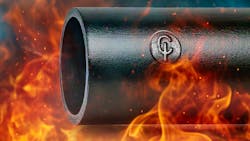Today’s building owners and facility managers face a high-stakes question: how do you choose plumbing materials that are durable, sustainable, code-compliant and cost-effective all at once? It’s a balancing act between long-term performance and short-term pressures. And with so many materials and marketing claims out there, it’s easy to feel overwhelmed.
The biggest debate centers on two contenders: cast iron soil pipe and fittings and plastic alternatives like PVC and ABS. Both have their pros and cons, but not all materials are created equal — especially when it comes to the unique demands of commercial construction.
Choosing the wrong piping system can mean frequent maintenance, unhappy tenants, unnecessary replacements or even fire and safety hazards.
Let’s break down four key factors that matter most: cost, noise control, performance and sustainability.
1. COST CONSIDERATIONS
Piping systems account for about 1% of the overall project cost in commercial buildings. Drain, waste and vent (DWV) piping is just one component of the piping systems. So the cost of DWV pipe is a small fraction of the overall cost. But it’s still important to look at both the initial material cost and the total installed cost. Only then can you truly decide which material is right for you.
Upfront vs. Long-Term Cost
Yes, PVC is cheaper. But that’s just the beginning. When you factor in additional costs — like firestopping, extra supports, insulation, more frequent repairs and earlier replacement — plastic’s “cheap” starts looking expensive.
Cast iron may cost more up front, but can pay you back in the long run. It’s easier to install in many cases (thanks to fewer add-ons), needs fewer repairs and lasts for generations.
Less Maintenance, Fewer Surprises
Plastic piping can sag, crack or leak under strain. And in buildings with high occupancy or demanding uses, those failures add up fast. Cast iron is less vulnerable to heat and physical stress — which means fewer callbacks, lower repair costs, and less downtime.
Insurance & Liability Benefits
Because cast iron doesn’t burn, many insurers offer lower premiums for buildings that use it. PVC’s fire risk can mean higher costs — not just in premiums, but also in liability exposure.
Cost Efficiency Winner: Cast Iron
2. NOISE CONTROL
According to recent studies by USA Today, plumbing noise is one of the most common complaints in multi-unit buildings — especially in hotels and hospitals, where peace and quiet aren’t just nice to have, they’re part of the guest or patient experience.
Why Cast Iron is Quieter
The denser the pipe material, the better it is at dampening sound. Cast iron naturally absorbs noise from flowing water and flushing toilets. PVC often requires insulation wraps and isolation brackets to reduce sound — which adds to your labor and materials bill.
Real-World Preference
Builders and engineers working on healthcare, hospitality and multi-family housing projects often choose cast iron. Not only does it create a better living and working environment — it also helps cut down on complaints and increases tenant satisfaction.
Noise Control Winner: Cast Iron
3. RESILIENCE & PERFORMANCE
Fire Resistance
In high-occupancy spaces like hospitals, hotels and office buildings, safety isn’t optional. PVC is combustible and emits toxic smoke when burned. To meet code, it typically requires fire wrap or added firestop measures — all of which add cost and complexity.
Cast iron is naturally non-combustible and requires no added protection.
Tough Under Pressure
Your plumbing system works hard. Between constant use, weather extremes and even seismic shifts, it needs to hold up. But PVC can warp, crack or collapse under stress. Cast iron, on the other hand, offers exceptional structural strength and long-term reliability.
Corrosion Resistance
Thanks to advances in modern coating technology, today’s cast iron is more corrosion-resistant than ever. So it’s built to perform in harsh environments like commercial kitchens, coastal buildings and low-flow systems that can be especially hard on materials.
Performance Winner: Cast Iron
4. SUSTAINABILITY
Recyclability
In today’s eco-conscious world, sustainability is no longer a bonus — it’s a requirement. Cast iron made in America is made from more than 96% post-consumer recycled content and is 100% recyclable at the end of its life. That means it’s not just built to last — it’s built to come back.
PVC? While technically recyclable, most of it isn’t. It often ends up in landfills, and as it degrades, it releases microplastics that pose long-term risks to the environment.
Longevity = Less Waste
PVC pipes can deteriorate within a few decades under stress. Cast iron, on the other hand, can exceed 50 years — and many historical buildings are still operating on their original cast iron plumbing, a century later. Fewer replacements mean less waste and a significantly lower environmental impact over time.
Carbon Footprint Matters
Manufacturing methods matter, too. PVC production creates high levels of greenhouse gas emissions. Cast iron, by contrast, uses recycled materials and more sustainable processes. When you factor in the energy used to produce, ship, install and dispose of the piping, cast iron leaves a lighter environmental footprint.
Green Building Ready
For facilities aiming for LEED certification or other green building benchmarks, cast iron checks all the boxes: recyclability, durability and lower total environmental impact.
Sustainability Winner: Cast Iron
PVC or Cast Iron? There’s Really No Comparison.
In an industry full of noise, it’s easy to make decisions based on marketing instead of facts. But when you step back and look at what truly matters — safety, sustainability, durability and cost — the choice is clear.
The Cast Iron Soil Pipe Institute (CISPI) is here to help facility managers and engineers make informed decisions that stand the test of time. With decades of research, testing and hands-on experience, CISPI provides expert guidance rooted in real-world performance. We’ll even tell you if PVC is the right fit.
But for the vast majority of commercial builds — when safety, budgets and reputations are on the line — cast iron delivers.
Get the Iron-Clad Truth at CISPI.org/ironcladtruth

